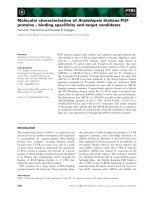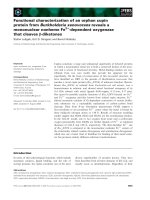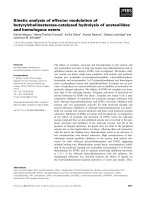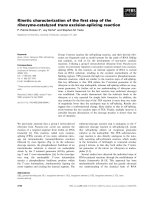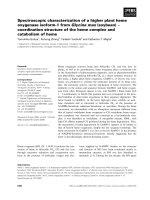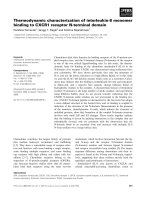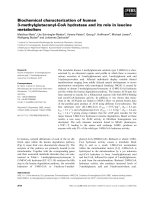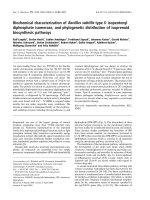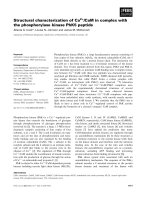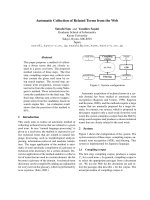Báo cáo khoa học: Kinetic characterization of methionine c-lyases from the enteric protozoan parasite Entamoeba histolytica against physiological substrates and trifluoromethionine, a promising lead compound against amoebiasis ppt
Bạn đang xem bản rút gọn của tài liệu. Xem và tải ngay bản đầy đủ của tài liệu tại đây (261.41 KB, 13 trang )
Kinetic characterization of methionine c-lyases from
the enteric protozoan parasite Entamoeba histolytica
against physiological substrates and trifluoromethionine,
a promising lead compound against amoebiasis
Dan Sato
1,
*, Wataru Yamagata
2
, Shigeharu Harada
2
and Tomoyoshi Nozaki
1
1 Department of Parasitology, Gunma University Graduate School of Medicine, Japan
2 Department of Applied Biology, Graduate School of Science and Technology, Kyoto Institute of Technology, Japan
Trans-sulfuration pathways are ubiquitous and play
various roles, including in the formation of Met and
Cys, transmethylation reactions, and the synthesis of
polyamines, antioxidants, and cofactors [1]. As there
are remarkable differences in trans-sulfuration
pathways between organisms, these pathways, and in
Keywords
amoebiasis; methionine c-lyase;
site-directed mutagenesis; sulfur-containing
amino acid; trifluoromethionine
Correspondence
T. Nozaki, Department of Parasitology,
Gunma University Graduate School of
Medicine, 3-39-22 Showa-machi, Maebashi,
Gunma 371-8511, Japan
Fax: +81 27 220 8020
Tel: +81 27 220 8025
E-mail:
Website: ma-u.
ac.jp/Enozaki_lab.html
*Present address
Institute for Advanced Biosciences, Keio
University, Tsuruoka, Yamagata, Japan
Database
Nucleotide sequence data are available in
the DDBJ ⁄ EMBL ⁄ GenBank databases under
the accession numbers AB094499
(EhMGL1) and AB094500 (EhMGL2)
(Received 29 August 2007, revised 13
November 2007, accepted 4 December
2007)
doi:10.1111/j.1742-4658.2007.06221.x
Methionine c-lyase (MGL) (EC 4.4.1.11), which is present in certain lin-
eages of bacteria, plants, and protozoa but missing in mammals, catalyzes
the single-step degradation of sulfur-containing amino acids (SAAs) to
a-keto acids, ammonia, and thiol compounds. In contrast to other organ-
isms possessing MGL, anaerobic parasitic protists, namely Entamoeba his-
tolytica and Trichomonas vaginalis, harbor a pair of MGL isozymes. The
enteric protozoon En. histolytica shows various unique aspects in its metab-
olism, particularly degradation of SAAs. Trifluoromethionine (TFM), a
halogenated analog of Met, has been exploited as a therapeutic agent
against cancer as well as against infections by protozoan organisms and
periodontal bacteria. However, its mechanism of action remains poorly
understood. In addition, the physiological significance of the presence of
two MGL isozymes in these protists remains unclear. In this study, we
compared kinetic parameters of the wild-type and mutants, engineered by
site-directed mutagenesis, of the two MGL isotypes from En. histolytica
(EhMGL1 and EhMGL2) for various potential substrates and TFM. Intra-
cellular concentrations of l-Met and l-Cys suggested that these SAAs are
predominantly metabolized by EhMGL1, not by EhMGL2. It is unlikely
that O-acetyl-l-serine is decomposed by EhMGLs, given the kinetic param-
eters of cysteine synthase reported previously. Comparison of the wild-type
and mutants revealed that the contributions of several amino acids impli-
cated in catalysis differ between the two isozymes, and that the degradation
of TFM is less sensitive to alterations of these residues than is the degrada-
tion of physiological substrates. These results support the use of TFM to
target MGL.
Abbreviations
CS, cysteine synthase; EhMGL, Entamoeba histolytica methionine c-lyase; Hcy, homocysteine; MGL, methionine c-lyase; OAS, O-acetyl-
L-serine; PG, L-propargylglycine; PLP, pyridoxal 5¢-phosphate; SAA, sulfur-containing amino acid; TFM, trifluoromethionine (S-trifluoromethyl-
L-homocysteine).
548 FEBS Journal 275 (2008) 548–560 ª 2008 The Authors Journal compilation ª 2008 FEBS
particular enzymes involved in the degradation of
sulfur-containing amino acids (SAAs), have been
exploited as a target for chemotherapeutic intervention
in cases of cancer and infectious diseases [2,3]. Methio-
nine c-lyase (MGL) is one such enzyme, a member of
the a-family of pyridoxal 5¢-phosphate (PLP)-depen-
dent enzymes [4]. MGL catalyzes the a,c-elimination
and c-replacement of l-Met and homocysteine (Hcy),
and a,b-elimination and b-replacement of l-Cys and
S-substituted analogs, and produces ammonia, a-keto
acids, and volatile thiols such as hydrogen sulfide and
methanethiol [5]. MGL has been characterized in
several bacteria, such as Pseudomonas putida [6], Clos-
tridium sporogenes [7], Aeromonas sp. [6], Citrobacter
intermedius [8], Citrobacter freundii [9], Brevibacterium
linens [10], and Porphyromonas gingivalis [11], parasitic
protozoa such as Trichomonas vaginalis [12] and
Entamoeba histolytica [13], and the plant Arabidopsis
thaliana [14].
MGL has been implicated in the degradation of
toxic SAAs [15], and also in energy metabolism
through the synthesis of pyruvate or 2-oxobutyrate in
En. histolytica [16]. Volatile thiol compounds have also
been implicated in the pathogenicity in vivo of the
periodontal bacterium, Po. gingivalis [11]. It has been
recently shown that in Ar. thaliana, a-ketobutyrate and
methanethiol, generated by MGL, are utilized for iso-
leucine biosynthesis and the production of S-methyl-
cysteine, the putative storage molecule for sulfide or
methyl groups, which is formed by the transfer of the
acetyl moiety of O-acetyl-l-serine (OAS) to methane-
thiol [14]. Unlike bacteria and plants, T. vaginalis and
En. histolytica have two isozymes of MGLs that differ
distinctly in substrate specificity [13,17]. However, the
physiological roles of individual isotypes as well as the
significance of their redundancy remain to be eluci-
dated.
Entamoeba histolytica, a causative agent of amoebi-
asis, affects an estimated 50 million people and results
in 70 000 deaths per year worldwide [18]. The major
clinical manifestations of amoebiasis are amoebic
dysentery and extraintestinal abscesses, namely, hepa-
tic, pulmonary and cerebral abscesses [19]. Although
clinical resistance against metronidazole, the drug cur-
rently used most widely for invasive amoebiasis [3],
has not yet been proven for clinical isolates, cases of
treatment failure have been reported [3]. In addition,
it was shown that metronidazole resistance was easily
gained in vitro [20,21]. Moreover, metronidazole
resistance is common in bacteria and the protozoan
flagellates Giardia intestinalis
and T. vaginalis [22].
Therefore, a novel amoebicidal drug is urgently
needed.
Trifluoromethionine [S-trifluoromethyl-l-homocyste-
ine (TFM)], a halogenated Met analog in which a
methyl moiety is replaced by a trifluoromethyl group
[23], has been shown to be highly toxic to various bac-
teria [24], including Po. gingivalis [25], T. vaginalis [26],
and En. histolytica [13] (Kobayashi and Nozaki,
unpublished data). TFM affected the growth of
En. histolytica and T. vaginalis trophozoites at micro-
molar levels in vitro [13,26], and also cured infections
in mouse and hamster models [26] (Kobayashi and
Nozaki, unpublished results). The limited presence of
MGL among organisms, and the remarkable differ-
ences in the toxicity of TFM against amoeba and
mammalian cells [IC
50
for En. histolytica trophozoites
or Chinese hamster ovary cells, 18 lm [13] or 865 lm
(unpublished results)], give further support for TFM
as a promising lead compound for the development of
new chemotherapeutics against amoebiasis.
For the further development of antiamoebic agents
based on TFM, elucidation of the underlying reaction
mechanisms of MGLs and the interaction of TFM with
the enzymes is required. In this study, we demonstrate
differences in substrate specificity and kinetic parame-
ters for four potential natural substrates and TFM of
both the wild-type and mutants, created by site-directed
mutagenesis of critical amino acid residues presumed to
play an important role in catalysis, of the two isotypes
of En. histolytica MGLs (EhMGL1 and EhMGL2).
The results clearly demonstrate that EhMGL1, not
EhMGL2, plays the predominant role in the degrada-
tion of Met and Cys in the amoeba trophozoites,
whereas OAS seems to be decomposed by neither
EhMGL1 nor EhMGL2. Our results also show that
TFM is mainly degraded by EhMGL2, but not by
EhMGL1. In addition, the contributions of the amino
acids implicated in previous studies [17,27,28] to the
catalysis of individual physiological and deleterious sub-
strates differ greatly between the two EhMGL isotypes.
The information provided by the present study should
help in the further rational design of novel chemothera-
peutic agents targeting MGL against amoebiasis.
Results and Discussion
Expression and purification of the genetically
engineered wild-type of EhMGL1
We were unable to precisely determine kinetic con-
stants for the reaction catalyzed by MGL isotypes
from En. histolytica, due to the heterogeneity of
EhMGL1 in the previous preparation [13] (approxi-
mately 20% of EhMGL1 was produced as a 35 kDa
truncated form; Fig. 1A, lane 1). Our attempt to
D. Sato et al. Kinetics of E. histolytica methionine c-lyases
FEBS Journal 275 (2008) 548–560 ª 2008 The Authors Journal compilation ª 2008 FEBS 549
further purify the full-length EhMGL1 with anion
exchange and gel filtration chromatography failed
(data not shown), suggesting that the truncated
EhMGL1 probably forms a heterogeneous tetrameric
complex with the full-length EhMGL1. We determined
the N-terminus of the truncated EhMGL1 to be Gly46
(Fig. 1B, boxed) by Edmann degradation of the
35 kDa band excised from the SDS ⁄ PAGE gel, and
postulated that the truncation was caused by a fortu-
itous initiation of translation at Met45 due to the simi-
larity of the nucleotide sequence upstream of Met45 of
EhMGL1 to the Shine–Dalgarno sequence (Fig 1B,
underlined). The truncated enzyme lacking a glutathi-
one S-transferase tag was purified by affinity chroma-
tography, indicating that the full-length version and
the truncated version form a tetramer. The truncation
is potentially deleterious to the stability and activity of
a tetramer, because this region is involved in a dimer–
dimer interaction and catalytic reaction (e.g. Ps. putida
MGL [28]). To eliminate the production of the trun-
cated EhMGL1, we replaced five nucleotides within
this region of the EhMGL1 gene without causing
amino acid substitutions (Fig. 1B, white lower-case on
a black background), and applied the engineered
EhMGL1 to protein expression. This genetically engi-
neered EhMGL1 was purified to > 95% homogeneity
without traceable contamination of the truncated form
(Fig. 1A, lane 2).
Comparison of the specific activity and kinetic
parameters for potential substrates between the
wild-type MGL isotypes
To understand the specific roles of the two MGL iso-
types, which show 69% mutual identity [13], and also
to demonstrate differences between them in reaction
mechanisms towards physiological substrates and
TFM, we determined the apparent specific activity
(with a constant substrate concentration of 2 mm) and
the kinetic parameters of recombinant EhMGL1 and
EhMGL2 (Tables 1 and 2). Despite the heterogeneity
of the EhMGL1 preparation used in the previous
study [13], the kinetic constants of EhMGL1 in the
present study largely agreed with the previous data,
except that the relative activity towards Cys and OAS
was underestimated by 4–5-fold previously (the relative
specific activities of EhMGL1 towards Cys and OAS
were 19.7% and 11.1% relative to that towards Met
[13], and 116% or 42.4% in the present study). The
discrepancy in the kinetic constants of EhMGL1 was
probably attributable to the heterogeneity of the
EhMGL1 preparation in the previous study. The V
max
A
B
Fig. 1. (A) Purified proteins (1.0 lg) were analyzed by 12% SDS ⁄ PAGE under reducing conditions, and stained with Coomassie brilliant blue.
Lane 1: wild-type MGL1. Lane 2: nucleotide-substituted MGL1. Lane 3: MGL2. Molecular mass markers are indicated on the right. (B) Partial
alignment of EhMGL1. Wild-type MGL1 (upper), nucleotide-substituted MGL1 (middle) and the deduced amino acids (lower) are aligned. The
five substituted nucleotides are indicated in lower-case on a black background. A box represents the N-terminal end of the truncated
sequence determined by Edmann degradation. The incidental Shine–Dalgarno-like sequence is underlined.
Kinetics of E. histolytica methionine c-lyases D. Sato et al.
550 FEBS Journal 275 (2008) 548–560 ª 2008 The Authors Journal compilation ª 2008 FEBS
(or the specific activity) of EhMGL2 against dl-Hcy
previously reported (V
max
, 1.31 lmol productÆ
min
)1
Æmg
)1
protein; relative specific activity compared
to that against Met, 162%) was also underestimated
(k
cat
, 10.56 s
)1
; relative specific activity 10.5-fold
higher than that for Met, in the present study). In
addition, the K
m
of EhMGL2 for OAS in the previous
study (0.89 mm) disagreed with that in the present
study (52.33 mm). We assumed that these differences
were attributable to the assay methods used; the a-keto
acid assay was employed in the present study, whereas
the nitrogen assay, which has less sensitivity, was used
previously. Taken together, the specificities of the two
isotypes are briefly summarized as follows. EhMGL1
showed comparable (within 1.1–3.1-fold differences)
specific activities towards OAS and all SAAs tested in
this study (0.59–1.83 lmol productÆmin
)1
Æmg
)1
pro-
tein), whereas EhMGL2 showed 10–20-fold more
activity with dl-Hcy than with other substrates (7.42
and 0.37–0.71 lmol productÆmin
)1
Æmg
)1
protein,
respectively).
The K
m
of EhMGL2 for Met (3.58 mm) is six-fold
higher than that of EhMGL1 (0.61 mm). In addition,
the k
cat
for Met of EhMGL1 is 1.6-fold higher than
that of EhMGL2. The k
cat
⁄ K
m
, which indicates the
catalytic efficiency [29], of EhMGL1 is 10-fold higher
than that of EhMGL2. Taking into account the intra-
cellular Met concentrations, measured by NMR
(2.1 ± 0.6 mm) or direct amino acid analysis (0.8 mm,
[30]), we speculate that EhMGL1, but not EhMGL2,
is involved in the degradation of Met under normal
conditions. Similarly, the 2.0-fold higher k
cat
and 2.7-
fold lower K
m
for Cys of EhMGL1 than of EhMGL2,
together with the intracellular Cys concentration
(0.4 mm [30]), suggest that EhMGL1, but not
EhMGL2, mainly catalyzes the degradation of Cys
in vivo. Although Hcy is an essential component of the
Met cycle [15], it is believed that Hcy must be main-
tained at low concentrations to avoid toxicity [31]. The
intracellular Hcy concentration is unknown in amoe-
bae, but is presumed to be several micromoles per liter,
as shown for human plasma [32], a much lower con-
centration than the K
m
of EhMGL1 and EhMGL2 for
Hcy (1.5–3.0 mm). Thus, although the k
cat
⁄ K
m
for
Hcy of EhMGL2 was 5.5-fold higher than that of
EhMGL1, the assumed Hcy concentrations suggest
that neither EhMGL plays a significant role in the
elimination of Hcy under physiological conditions.
Kinetic parameters against OAS also revealed that
the two EhMGLs have discernible catalytic properties
(EhMGL1, 6.28 mm and 1.74 s
)1
, and EhMGL2,
52.33 mm and 6.22 s
)1
, for K
m
and k
cat
, respectively).
Although the intracellular OAS concentration is
unknown for amoebae, the presence of multiple iso-
types of cysteine synthase (CS) makes it unlikely that
EhMGLs are involved in the degradation of OAS. CS,
which generates Cys from H
2
S and OAS, has advanta-
ges (e.g. K
m
and k
cat
of EhCS1 are 1.27 mm and
395 s
)1
, respectively) for OAS, as compared to
EhMGLs [33]. Three isotypes of CS are constitutively
expressed, as shown by immunoblotting [34] and a
transcriptome analysis with a DNA microarray [35].
Thus, OAS is most likely utilized predominantly by
CS. Taken together, these findings suggest that
EhMGL1 is responsible for the decomposition and the
maintenance of the cellular concentrations of Met and
Cys, whereas the physiological substrates of EhMGL2
under normal growth conditions remain unknown.
Table 1. Specific activities of wild-type and mutant EhMGL1 (A) and EhMGL2 (B). Apparent specific activity (mean ± SD in triplicate) is
shown as lmol of a-keto acid producedÆmin
)1
Æmg
)1
protein. ND, activity not detected (less than 0.05 lmol of product per min per mg of
protein).
(A)
Substrate Wild-type Y108F C110S C110G R55A
L-Methionine 1.39 ± 0.01 0.23 ± 0.02 1.11 ± 0.08 0.56 ± 0.04 ND
Trifluoromethionine 1.16 ± 0.10 2.54 ± 0.28 4.78 ± 0.19 1.61 ± 0.10 1.01 ± 0.15
DL-Homocysteine 1.83 ± 0.26 0.38 ± 0.05 1.18 ± 0.05 0.77 ± 0.02 ND
L-Cysteine 1.61 ± 0.35 0.52 ± 0.06 1.06 ± 0.26 1.12 ± 0.12 0.10 ± 0.01
O-Acetyl-
L-serine 0.59 ± 0.12 0.67 ± 0.09 0.29 ± 0.04 0.82 ± 0.01 0.14 ± 0.02
(B)
Substrate Wild-type Y111F C113S C113G R58A
L-Methionine 0.71 ± 0.02 ND 0.06 ± 0.0001 0.08 ± 0.002 ND
Trifluoromethionine 14.03 ± 2.03 7.76 ± 1.05 8.14 ± 0.70 14.67 ± 0.54 0.78 ± 0.05
DL-Homocysteine 7.42 ± 1.02 0.64 ± 0.17 1.90 ± 0.11 2.34 ± 0.06 ND
L-Cysteine 0.62 ± 0.02 0.15 ± 0.01 0.09 ± 0.01 0.75 ± 0.03 ND
O-Acetyl-
L-serine 0.37 ± 0.04 0.26 ± 0.02 0.06 ± 0.01 0.90 ± 0.05 ND
D. Sato et al. Kinetics of E. histolytica methionine c-lyases
FEBS Journal 275 (2008) 548–560 ª 2008 The Authors Journal compilation ª 2008 FEBS 551
Table 2. Kinetic parameters of wild-type and mutant EhMGL1 (A) and EhMGL2 (B). Kinetic parameters were measured with at least five different concentrations. Values are means ± SD
in triplicate. ND, not detectable; NT, not tested.
(A)
Substrate
Wild-type Y108F C110S C110G R55A
K
m
(mM)
±SD
k
cat
(s
)1
)
±SD k
cat
⁄ K
m
K
m
(mM)
±SD
k
cat
(s
)1
)
±SD
k
cat
⁄
K
m
K
m
(mM)
±SD
k
cat
(s
)1
)
±SD k
cat
⁄ K
m
K
m
(mM)
±SD
k
cat
(s
)1
)
±SD k
cat
⁄ K
m
K
m
(mM)
±SD
k
cat
(s
)1
)
±SD k
cat
⁄ K
m
L-Methionine 0.61 ± 0.06 1.82 ± 0.11 2.99 NT NT NT 0.72 ± 0.02 0.93 ± 0.15 1.29 0.19 ± 0.01 0.36 ± 0.03 1.91 NT NT NT
Trifluoromethionine 0.10 ± 0.00 0.81 ± 0.08 8.02 0.57 ± 0.02 2.22 ± 0.08 3.88 NT NT NT NT NT NT 0.83 ± 0.05 1.26 ± 0.06 1.52
DL-Homocysteine 3.03 ± 0.06 3.92 ± 0.15 1.30 NT NT NT NT NT NT NT NT NT NT NT NT
L-Cysteine 0.64 ± 0.01 1.59 ± 0.14 2.48 1.01 ± 0.07 0.67 ± 0.06 0.66 0.46 ± 0.05 0.78 ± 0.03 1.69 0.34 ± 0.02 1.01 ± 0.02 3.00 NT NT NT
O-Acetyl-
L-serine 6.28 ± 0.53 1.74 ± 0.12 0.28 NT NT NT NT NT NT NT NT NT NT NT NT
(B)
Wild-type Y111F C113S C113G R58A
K
m
(mM)
±SD
k
cat
(s
)1
)
±SD k
cat
⁄ K
m
K
m
(mM)
±SD
k
cat
(s
)1
)
±SD k
cat
⁄ K
m
K
m
(mM)
±SD
k
cat
(s
)1
)
±SD k
cat
⁄ K
m
K
m
(mM)
±SD
k
cat
(s
)1
)
±SD k
cat
⁄ K
m
K
m
(mM)
±SD
k
cat
(s
)1
)
±SD k
cat
⁄ K
m
L-Methionine 3.58 ± 0.30 1.11 ± 0.13 0.31 NT NT NT 15.12 ± 0.24 0.47 ± 0.05 0.03 ND
a
ND
a
ND
a
NT NT NT
Trifluoromethionine 0.92 ± 0.06 17.46 ± 1.21 19.05 0.29 ± 0.0003 5.80 ± 0.54 20.29 NT NT NT NT NT NT 1.62 ± 0.15 1.19 ± 0.11 0.73
DL-Homocysteine 1.47 ± 0.12 10.56 ± 1.25 7.19 NT NT NT NT NT NT NT NT NT NT NT NT
L-Cysteine 1.70 ± 0.09 0.80 ± 0.08 0.47 ND NT NT 5.45 ± 0.09 0.24 ± 0.01 0.04 ND
a
ND
a
ND
a
NT NT NT
O-Acetyl-
L-serine 52.33 ± 1.52 6.22 ± 0.61 0.12 NT NT NT NT NT NT NT NT NT NT NT NT
a
K
m
is estimated to be less than 0.1 mM.
Kinetics of E. histolytica methionine c-lyases D. Sato et al.
552 FEBS Journal 275 (2008) 548–560 ª 2008 The Authors Journal compilation ª 2008 FEBS
Kinetic parameters of mutants of the
two MGL isotypes
Among the several amino acid residues shown to inter-
act with PLP, the importance of a few was evaluated
in the amoebic MGL isotypes. Our preliminary crystal-
lographic study suggests that Tyr111, Cys113 and
Arg58 of EhMGL2 are oriented towards PLP in close
proximity [36] (data not shown). Tyr114 of Ps. putida
MGL (corresponding to Tyr108 and Tyr111 of
EhMGL1 and EhMGL2, respectively) was implicated
in c-elimination, attacking the c-position of a substrate
as an acid catalyst [14]. Cys110 and Arg55 of
EhMGL1, which correspond to Cys113 and Arg58 of
EhMGL2, are also predicted to be located in similar
positions.
MGL1(Y108F) and MGL2(Y111F) showed a 79–
100% reduction in the a,c-elimination of both Met
and Hcy as compared to the wild-type MGLs, whereas
these mutations only slightly affected the a,b-elimina-
tion of OAS (a 1.14-fold increase or only a 28% reduc-
tion as compared to wild-type MGL1 or MGL2,
respectively). These results were similar to the Tyr114
mutant of Ps. putida MGL [27]. Unlike the case of
OAS, MGL1(Y108F) and MGL2(Y111F) showed
reduced a,b-elimination for Cys (68% or 76% reduc-
tion); for example, MGL1(Y108F) showed a 1.6-fold
increase in the K
m
and a 58% decrease in the k
cat
for
Cys. This implies that the hydroxyl group of Tyr108 of
EhMGL1 is actively involved in the b-elimination and
c-elimination of the C–S bond, but not the b-elimina-
tion of the C–O bond, of OAS.
The Cys near the active site was shown to be impor-
tant for activity by chemical modification with
2-nitrothiocyanobenzoic acid and labeling with a PLP
analog, N-(bromoacetyl)pyridoxamine phosphate, in
Ps. putida MGL [37,38]. Cys116 was shown to be
located in close proximity to Tyr114 [28]. This Cys is
not conserved in other PLP a-family enzymes; Cys is
substituted by Gly or Pro in cystathionine c-lyase,
cystathionine b-lyase, and cystathionine c-synthase
[27,28]. In B. linens MGL, Gly is substituted for Cys
at this position. B. linens MGL degrades neither Cys
nor cystathionine [10], whereas Ar. thaliana MGL
decomposes Cys but degrades cystathionine only mar-
ginally, in spite of the presence of Gly at this position
[39]. The Cys to Ser or Thr mutations of Ps. putida
MGL caused a reduction in activity [28]. Neither
En. histolytica MGL nor T. vaginalis wild-type MGL
degrades cystathionine [13,17]. The Cys fi Gly muta-
tion of T. vaginalis MGLs reduced c-elimination activ-
ity towards Met and Hcy 5–13-fold, but only slightly
changed b-elimination activity for Cys and
OAS (0.38–2.5-fold) [17]. Thus, it was proposed that
this Cys plays an important role in substrate specific-
ity, i.e. the preference of substrates for c-elimination in
T. vaginalis MGLs.
Amoebic MGL2(C113S) showed reduced activities
towards Met, Cys, and Hcy (9–26% of that of the
wild-type), whereas MGL1(C110S) showed only a
marginal reduction (65–80% of that of the wild-type).
MGL1(C110S) and MGL2(C113S) showed reduced
k
cat
values for Met or Cys (49–51% or 29–42% of that
of wild-type MGL1 or MGL2, respectively), whereas
the K
m
values remained unchanged for MGL1(C110S)
(72–118% of that of the wild-type) or increased
3.2–4.2-fold for MGL2(C113S). In contrast to the
Cys fi Ser mutation, the Cys fi Gly mutation caused
2.5-fold and 1.4-fold increases in activity towards OAS
for MGL1(C110G) and MGL2(C113G), respectively.
MGL2(C113G) also showed a 20% higher level of
activity towards Cys than wild-type MGL2. Interest-
ingly, the K
m
values of MGL1(C110G) for Met and
Cys were reduced by 70% and 48%, respectively. In
contrast, the k
cat
values of MGL1(C110G) for Met
and Cys decreased by 80% and 34%, respectively.
Additionally, MGL1(C110G)-catalyzed reactions of
Met or Cys showed saturation with 0.125 m substrate,
suggesting the K
m
to be < 0.1 mm (Table 1, indicated
by asterisks). Taken together, these findings show that
the contribution of this Cys to the catalytic reaction
clearly differs between EhMGL1 and EhMGL2;
Cys113 of MGL2 is heavily involved in substrate speci-
ficity, whereas Cys110 of MGL1 is not so essential for
catalysis. However, as mutations of Cys110 of MGL1
produced 56% and 32% reductions in the specificity
constants with Met and Cys, respectively, this residue
might be also important for catalysis.
Arg55 of EhMGL1 and Arg58 of EhMGL2 are
located near the PLP of the neighboring subunit of the
catalytic dimer, as revealed by X-ray crystallography
(unpublished data), similar to what is found for MGLs
from Ps. putida [28] and Ci. freundii [40]. The mutation
of this Arg to Ala was shown to abolish the activity
for Met of Ps. putida MGL [28]. Similarly, the R58A
mutation of MGL2 completely abolished activity
towards Met, Cys, Hcy, and OAS, whereas residual
activity remained for MGL1(R55A) towards Cys and
OAS, but not Met and Hcy. We confirmed by gel
filtration that the apparent molecular mass of
MGL1(R55A) and MGL2(R58A) was approximately
175 kDa, similar to that of wild-type MGLs (data not
shown). Thus, interference with dimerization was not a
reason for the observed loss of activity. It was also
shown that a mutant containing the corresponding
Arg mutation formed a tetramer in Ps. putida MGL
D. Sato et al. Kinetics of E. histolytica methionine c-lyases
FEBS Journal 275 (2008) 548–560 ª 2008 The Authors Journal compilation ª 2008 FEBS 553
[28]. It is worth considering the utilization of
MGL1(R55A) and MGL2(R58A) mutants for domi-
nant negative effects, because these EhMGL mutants
were shown to be associated with endogenous EhMGL
in a heterotetrameric complex (data not shown).
Kinetic parameters of MGL wild-type and
mutants towards TFM
The specific activity of EhMGL2 against TFM was
12-fold higher than that of EhMGL1. This increase is
mostly attributable to a large difference in k
cat
; the k
cat
of EhMGL2 was 21-fold higher than that of EhMGL1
(17.5 s
)1
and 0.81 s
)1
). By contrast, the K
m
of
EhMGL2 was nine-fold higher than that of EhMGL1
(0.92 and 0.10 mm, respectively). Thus, the catalytic
efficiency, expressed as k
cat
⁄ K
m
, of EhMGL2 is only
2.4-fold higher than that of EhMGL1 (19.05 and 8.02,
respectively; Table 2). It is remarkable that the k
cat
of
EhMGL1 for TFM was comparable to that for Met
and Cys, whereas the k
cat
of EhMGL2 for TFM was
16–22-fold higher than that for these physiological
substrates. The K
m
of EhMGLs for TFM was 52–470-
fold lower than that of the closest mammalian counter-
part (rat liver cystathionine c-lyase, K
m
=48mm)
[41].
None of the mutations examined in this study,
except for MGL2(R58A), greatly affected the activity
towards TFM, suggesting that the mechanism of the
MGL-catalyzed reaction of TFM is relatively indepen-
dent of these amino acids, unlike the case for physio-
logical substrates. The activity of MGL2(R58A)
towards TFM was similar to that of wild-type MGL
for the physiological substrates. Moreover, the effects
of the Y108F substitution on the K
m
and k
cat
of
EhMGL1 for TFM are opposite to those of Y111F of
EhMGL2; the K
m
and k
cat
of EhMGL1(Y108F)
increased 5.6-fold and 2.7-fold, respectively, as com-
pared to those of wild-type EhMGL1, whereas the K
m
and k
cat
of EhMGL2(Y111F) decreased threefold. The
Tyr fi Phe mutation caused only a 2.1-fold reduction
in the catalytic efficiency (k
cat
⁄ K
m
) of EhMGL1 (8.02
to 3.88), whereas the corresponding mutation of
EhMGL2 did not have a significant effect (19.05 to
20.29). The degradation of TFM probably proceeds
without interaction with Tyr111, Cys113, and Arg58
(in the case of EhMGL2), possibly due to the electro-
negativity of the trifluoromethyl group of TFM. It is
also worth noting that the role of Tyr108 (or Tyr111)
in the degradation of TFM significantly differs
between EhMGL1 and EhMGL2.
As indicated, EhMGL2, but not EhMGL1, dis-
played a remarkable preference for TFM. Although
elucidation of the mechanisms responsible for this
observation await further study, we speculate that the
preference is associated with the functional group
bound to the c-carbon: the trifluoromethyl moiety.
EhMGL2 also showed a remarkable preference for
Hcy, similar to TFM. Three fluorides on the methyl
carbon of TFM and a sulfur atom of the thiol group
of Hcy may participate in the formation of additional
hydrogen bonds in the catalytic pocket. Although we
previously reported X-ray crystallography of EhMGL2
[36], EhMGL2 cocrystallized with either TFM or Hcy
has not yet been obtained.
Crosslinking of EhMGLs and a scavenger protein
by TFM
It was previously proposed that a thiol derived from
the degradation of TFM by MGL, carbonothionic
difluoride, crosslinks the primary amino group of pro-
teins, which results in toxicity [41]. This model was
supported by the detection of released fluoride, a
byproduct of crosslinking with carbonothionic difluo-
ride [41]. We attempted to directly demonstrate that
TFM-derived product(s) causes protein modification.
We investigated whether the recombinant EhMGL was
modified after the incubation with TFM by examining
the mobility of the proteins by SDS ⁄ PAGE. When
recombinant EhMGL1 or EhMGL2 was incubated
with TFM, at least three additional bands were found
(Fig. 2A, lane 1, open arrowheads). Incubation of
EhMGLs with Met or without substrates did not result
in the appearance of these bands (Fig. 2A, lanes 2 and
3). Preincubation of EhMGLs with l-propargylglycine
(PG), a suicide substrate of PLP–enzyme, prior to the
mixing with TFM, abolished these extra bands
(Fig. 2A, lane 4). Immunoblot assay with antibody to
EhMGL2 (Fig. 2C) showed that when EhMGL1 was
reacted with TFM, but not with Met, or pretreated
with PG, EhMGL1 was no longer recognized by the
antibody (the equal loading of proteins was verified by
silver staining; Fig. 2A), suggesting that EhMGL1 was
chemically altered by unknown modifications caused
by the decomposition of TFM catalyzed by MGL.
Suppression of the antibody’s reactivity by the treat-
ment with TFM was also observed for EhMGL2, but
not for EhMGL1. The additional bands described
above (open arrowheads) were not recognized by the
antibody, suggesting that these bands were also chemi-
cally modified. Alternatively, these bands were not
derived from EhMGLs, but were minor contaminants
in the recombinant protein preparations. To examine
whether irrelevant proteins can also serve as scavengers
of carbonothionic difluoride produced from TFM by
Kinetics of E. histolytica methionine c-lyases D. Sato et al.
554 FEBS Journal 275 (2008) 548–560 ª 2008 The Authors Journal compilation ª 2008 FEBS
EhMGLs, MGL was incubated with TFM in the pres-
ence or absence of BSA, electrophoresed, and silver-
stained or immunoblotted with antibody to EhMGL2
(Fig. 2B). Although we did not observe BSA-derived
extra bands, the band corresponding to BSA on a
silver-stained gel was smeared only when BSA was
incubated with TFM and EhMGLs (gray arrows), sug-
gesting that unknown modifications or degradation of
BSA probably occurred.
As we observed differences in reactivity with the
TFM-derived product between the two EhMGLs, we
examined whether the sensitivities of the two EhMGLs
to inactivation by TFM differ. We preincubated
EhMGLs with TFM at a molecular ratio of 1 : 1000,
and further tested for the Met-degrading activity on
the basis of the detection of a-keto acid after the addi-
tion of 2 mm Met (Fig. 3). Approximately 85% of
EhMGL2 activity remained after 1 h, whereas 75% of
EhMGL1 activity was lost. MGL activity following
preincubation with Met was indistinguishable from
that without preincubation, confirming that the
decrease was not due to inactivation of MGL during
the preincubation. These results clearly showed that
significant differences in sensitivity to TFM exist
between the two EhMGLs. Although we did not iden-
tify specific proteins that were crosslinked and inacti-
vated in vivo by the MGL-mediated degradation of
TFM, except for the amoebic MGL itself, we speculate
that carbonothionic difluoride generates crosslinks
surrounding proteins in the cytosol of the parasite,
leading to the observed toxicity to the cell.
The fact that EhMGL2, which is more active in the
degradation of TFM, is less sensitive than EhMGL1
seems to contradict the notion that the product of the
degradation is the enzyme inactivator. However, we
speculate that the distribution of possible primary
amines, which are target of the TFM adducts (carbo-
nothionic difluoride), in close proximity to the catalytic
pocket differs between MGL1 and MGL2, and that
this difference may influence the sensitivity to the
97.2
66.4
45.0
29.0
20.5
kDa
MGL1
1 2 3 4
MGL2
1 2 3 4
97.2
66.4
45.0
29.0
20.5
kDa
97.2
66.4
45.0
29.0
20.5
kDa
MGL1
1 2 3 4
BSA
1 2 3 4
MGL2
1 2 3 4
MGL1+BSA
1 2 3 4
MGL2+BSA
1 2 3 4
A
C
B
Fig. 2. In vitro crosslinking by TFM produced by recombinant MGLs. (A) The recombinant EhMGL1 or EhMGL2 or BSA was preincubated
with 4 m
M PG (lane 4) or without PG (lanes 1–3) for 30 min at 37 °C, and incubated with 4 mM TFM (lanes 1 and 4), Met (lane 2) or 2.5%
dimethylsulfoxide (control, lane 3) in 100 m
M sodium phosphate (pH 7.0) containing 20 lM PLP and 1 mM dithiothreitol for 1 h at 37 °C. The
reaction mixtures containing 50 ng of EhMGL or 100 ng of BSA were electrophoresed on a 5–20% SDS ⁄ PAGE gel under reducing condi-
tions, and subjected to silver staining. (B) The same reactions were performed with the mixtures of EhMGL and BSA. (C) The reaction mix-
tures of (A) were subjected to immunoblot analysis with antibody to EhMGL1 (left) or EhMGL2 (right). One-fourth of the volume of each
reaction mixture (corresponding to 25 ng of EhMGL) was analyzed. Open arrowheads, filled arrowheads and gray arrows depict the bands
that appeared upon incubation with TFM, contaminants of MGL preparations, and a smeared band probably corresponding to crosslinked
BSA, respectively. Molecular mass markers are indicated on the right.
D. Sato et al. Kinetics of E. histolytica methionine c-lyases
FEBS Journal 275 (2008) 548–560 ª 2008 The Authors Journal compilation ª 2008 FEBS 555
inactivation by the TFM adducts. A comparison of
primary structures indicated that 28 basic amino acids
(i.e. Lys and Arg) were conserved, whereas eight and
12 are unique to MGL1 and MGL2, respectively [13].
Thus, these eight MGL1-specific Lys and Arg residues
may be involved in the inactivation by TFM adducts.
Roles of two MGL isotypes in En. histolytica
The kinetic parameters of the two MGL isotypes sug-
gest that EhMGL1 is the primary isotype involved in
the degradation of Met and Cys. Both an immunoblot
study [13] and a transcriptome analysis (supplemental
data of [35]) showed that EhMGL1 and EhMGL2
were expressed at comparable levels. To directly con-
firm the in vivo activity of the two isozymes in the par-
asite, we measured specific activities of MGL in the
amoebic extracts using two representative physiological
substrates, i.e. Met and Hcy. The specific activities
with Met and Hcy in the parasite lysate (the 15 000 g
supernatant fraction) were 0.456 and 2.28 nmol of
productÆmin
)1
Æmg
)1
of lysate, respectively. Assuming
that the substrate specificity is similar between native
and recombinant EhMGLs and that recombinant
EhMGLs are fully active, the EhMGL1 ⁄ EhMGL2
ratio was determined to be 1 : 1.38 (data not shown).
This ratio agreed well with the data from the immuno-
blot and transcriptome analyses. The constitutive
expression of EhMGL1 and EhMGL2 in vitro ([13]
and this study) and in vivo [35] strongly suggests that
both isotypes play indispensable and nonoverlapping
roles during proliferation and intestinal infection. As
the K
m
of EhMGL2 for most naturally occurring
SAAs and related compounds was significantly higher
than that of EhMGL1, the physiological substrates of
EhMGL2 and precise biological role of MGL2 in vivo
under normal growth conditions are still not well
understood. However, it is conceivable that EhMGL1
plays a central role in the control of SAA concentra-
tions in the cell under normal conditions, whereas
EhMGL2 is involved in the control of SAA homeosta-
sis in cases where intracellular SAA concentrations are
elevated to toxic levels, e.g. on exposure to high con-
centrations of Cys precursors, including Ser, or the
engulfment of excessive amounts of bacteria or host
cells. This can be interpreted as follows to explain the
regulatory mechanism of the intracellular Met concen-
tration. Under physiological Met or Cys concentra-
tions, EhMGL1 is fully active, whereas EhMGL2 is
only partially active, due to its higher K
m
and lower
k
cat
⁄ K
m
. However, at higher Met concentrations,
EhMGL2 plays an supplementary role in reducing the
concentration of this toxic amino acid. In addition,
EhMGL2 may be present specifically to degrade Hcy.
Gilchrist et al. [35] reported that EhMGL1 was over-
expressed 15-fold at the mRNA level 1 day after amoe-
bae were inoculated into the mouse cecum, but not a
month later, when they colonized the intestine (only
1.3-fold increase), whereas EhMGL2 mRNA was
repressed 1.8–4.2-fold during this period [35], suggest-
ing that the expression of EhMGL1 is induced under
stress conditions. We also speculate that EhMGL2
may prefer substrates other than those used in this study,
e.g. S-adenosylmethionine, S-adenosylhomocysteine,
and S-methylmethionine. The reaction catalyzed by
MGLs is considered to be unidirectional, because one
of the products from Met, methanethiol, is highly vol-
atile and immediately evaporates extracellularly [25].
0
0.2
0.4
0.6
0.8
1
1.2
AB
010203040
min
010203040
min
mM αKB from Met in
incubation mixture
m
M αKB from Met in
incubation mixture
0
0.1
0.2
0.3
0.4
0.5
0.6
0.7
0.8
Fig. 3. Inactivation of MGL by incubation with TFM. The recombinant EhMGL1 [(A) 15 ngÆlL
)1
] or EhMGL2 [(B) 30 ngÆlL
)1
] was preincubat-
ed with 0.35 m
M or 0.7 mM TFM respectively (filled circles), PG (diamonds), Met (crosses) or control (0.625% dimethylsulfoxide) (open
circles) at 37 °C for 1 h. After preincubation, the mixtures were further incubated with 2 m
M Met for 0, 12, 24 or 36 min, and the amount of
a-keto acid was measured. The means for the triplicate measurements of the amount of a-keto acids produced after the addition of 2 m
M
Met are plotted. Error bars are omitted for clarity (standard errors < 0.03).
Kinetics of E. histolytica methionine c-lyases D. Sato et al.
556 FEBS Journal 275 (2008) 548–560 ª 2008 The Authors Journal compilation ª 2008 FEBS
However, as it is not reasonable to speculate that
En. histolytica discharges methanethiol, while it incor-
porates sulfide, we propose that En. histolytica salvages
methanethiol. This is plausible if En. histolytica pos-
sesses a pathway to produce Cys from Met in which
MGL is used to provide reactive thiol molecules such
as sulfide and methanethiol, which are in turn utilized
as substrates to form Cys and S-methylcysteine as pro-
posed for Ar. thaliana [14]. One of the major thiols
produced by amoebic MGLs, hydrogen sulfide, is
probably assimilated to form Cys in a reaction also
catalyzed by CS [34]. This organism has three isozymes
of CS [42], which convert OAS and hydrogen sulfide
to Cys [15]; one of these may utilize methanethiol
instead of hydrogen sulfide as an alanyl acceptor.
Genes encoding enzymes that utilize methanethiol as a
substrate, such as O-acetylhomoserine sulfhydrylase
(EC 2.5.1.49) and methanethiol oxidase (EC 1.8.3.4),
are not present in the En. histolytica database. Meta-
bolomics or fluxomics using amoebic transformants
overexpressing EhMGL1 or EhMGL2 should elucidate
the physiological substrates and functions of these
enzymes.
The excellent reactivity of TFM, a promising lead
to target MGL
We demonstrated in this study that TFM is an ideal
lead compound as a prodrug targeting MGL, from
an enzymological point of view. The excellent ability
of TFM to act as a prodrug is primarily attributable
to the high k
cat
and low K
m
of MGL2 against TFM.
It is considered that both EhMGL1 and EhMGL2
are, despite their clear differences in K
m
and k
cat
,
probably responsible for the decomposition of TFM,
because the concentration that is effective against the
amoebae is two orders of magnitude lower than the
K
m
values. It was reported that the incorporation of
TFM into proteins and recycling via the Met cycle
are extremely poor [43,44], which reinforces the
notion that TFM and its derivatives are not very
toxic to mammalian cells (data not shown). Finally,
the elucidation of reaction mechanisms against both
physiological substrates and prodrugs such as TFM
should provide a rationale for the further design of
TFM derivatives.
Experimental procedures
Chemicals
All chemicals of analytical grade were purchased from Wako
Pure Chemical Industries (Osaka, Japan) or Sigma-Aldrich
(St Louis, MO, USA) unless otherwise stated. PG was pur-
chased from PepTech Corp. (Burlington, MA, USA). TFM
was a gift from T. Toru and N. Shibata (Graduate School
of Engineering, Nagoya Institute of Technology, Nagoya,
Japan).
Mutagenesis, expression and purification of
recombinant enzymes
To eliminate the production of a truncated EhMGL1 in
Escherichia coli, due to the fortuitous translation initiation
at the second Met (Met45) within the coding region, five
synonymous nucleotide changes were introduced into
EhMGL1 (accession number AB094499). Nested PCR was
performed with appropriate oligonucleotide primers (sup-
plementary Table S1) and pGEX6P1–EhMGL1 [13] as tem-
plate, and subsequently with primers having BamHI and
XbaI sites for ‘nested PCR’, using the first PCR product as
template. To make use of the BamHI site in the vector and
the XbaI site in the EhMGL1 gene, the product of the nes-
ted PCR was replaced with the corresponding region in
pGEX–EhMGL1 [13] to produce pGEX–EhMGL1fl. The
following mutations were introduced into EhMGL1 and
EhMGL2 (AB094500), using the GeneTailor site-directed
mutagenesis system (Invitrogen, Carlsbad, CA, USA):
Y108F, C110S, C110G and R55A in EhMGL1; and
Y111F, C113S, C113G and R58A in MGL2. PCRs were
performed with the corresponding oligonucleotide primers
(supplementary Table S1) and methylated pGEX–
EhMGL1fl and pGEX–EhMGL2 [13] as templates. The
transformation and selection of mutated plasmids were per-
formed according to the instructions of the manufacturer.
Both wild-type and mutated proteins were expressed and
purified as described previously [13,36].
Activity assay and measurement of kinetic
parameters
The MGL activity was measured on the basis of the pro-
duction of a-keto acids [45]. Assays were carried out in
60 lL of 100 mm sodium phosphate (pH 7.0) containing
1mm dithiothreitol and 20 lm PLP, and 3–60 lgÆmL
)1
of
the recombinant enzymes, at 37 °C for 10 min. The ranges
of substrate concentrations for the measurement of kinetic
parameters were 0.125–20 mm for Met, Cys, OAS, and
TFM, and 0.125–2 mm for Hcy. Specific activity with 2 mm
substrates was also measured. These measurements were
performed independently. To assay the activity of MGLs in
the parasite, amoeba cells were lysed with 100 mm sodium
phosphate (pH 7.0) containing 20 lm PLP and 0.1%
Triton X-100. The insoluble materials were eliminated by
centrifugation at 15 000 g for 10 min, and subsequently
12.4 and 1.24 mgÆmL
)1
of the supernatant was incubated
with 2 mm Met and Hcy, respectively. After the reaction
D. Sato et al. Kinetics of E. histolytica methionine c-lyases
FEBS Journal 275 (2008) 548–560 ª 2008 The Authors Journal compilation ª 2008 FEBS 557
was terminated by the addition of 6 lL of 50% trichloro-
acetic acid, the solution was centrifuged at 15 000 g for
10 min at 4 °C, and 39.3 lL of the supernatant was incu-
bated with 110 lL of 0.33 m sodium acetate (pH 5.0) con-
taining 1.55 mm 3-methyl-2-benzothiazolinone hydrazone
hydrochloride hydrate for 1 h at 50 °C. The amounts of
azines generated were estimated by measuring absorbance
at 320 nm [45], with pyruvic acid and sodium 2-oxobutyrate
as standards. The kinetic parameters were estimated using
Hanes–Woolf plots.
Crosslinking of recombinant MGLs
The purified recombinant MGL1 or MGL2 (at a final con-
centration of 60 ngÆlL
)1
each) was incubated with 1 mm
TFM or Met in 100 mm sodium phosphate (pH 7.0)
containing 20 lm PLP in the presence or absence of
120 ngÆlL
)1
BSA for 1 h at 37 °C. For some experiments,
the recombinant MGLs were preincubated with 10 mm PG
for 30 min at 37 °C before the substrates were added. The
reaction mixtures were electrophoresed on a 5–20% gradi-
ent SDS ⁄ PAGE gel under reducing conditions, and proteins
were detected with silver staining and immunoblot analysis
with antibody to MGL1 or MGL2 [13].
Measurement of remaining MGL activity after
the incubation with TFM
The recombinant MGL1 (15 ngÆlL
)1
) and MGL2
(30 ngÆlL
)1
) were mixed with 0.35 mm or 0.7 mm TFM,
PG and Met at 37 °C in 100 mm sodium phosphate
(pH 7.0) containing 20 lm PLP. The molar ratio of MGL
to substrate or inhibitor was maintained at 1 : 1000. After
1 h of preincubation, 2 mm Met was added, and the
amount of a-keto acid was measured after 0, 12, 24 and
36 min, as described above. After the amount of a-keto-
butyric acid produced in the preincubation mixture was
subtracted, the estimated amount of a-keto acid generated
after the addition of 2 mm Met was plotted.
Acknowledgements
The authors thank Kayoko Hashimoto and Rumiko
Kosugi for technical assistance and Norio Shibata and
Takeshi Toru, Nagoya Institute of Technology, for the
synthesis of TFM and constructive discussions. This
work was supported in part by Grants-in-Aid for
Scientific Research from the Ministry of Education,
Culture, Sports, Science and Technology of Japan
(17390124, 17790282, 18050006, and 18073001), a
grant for Research on Emerging and Re-emerging
Infectious Diseases from the Ministry of Health,
Labour and Welfare (01712004), and a grant for the
Project to Promote the Development of Anti-AIDS
Pharmaceuticals from the Japan Health Sciences Foun-
dation (KA11501) to T. Nozaki.
References
1 Brosnan JT & Brosnan ME (2006) The sulfur-contain-
ing amino acids: an overview. J Nutr 136, 1636S–1640S.
2 Cellarier E, Durando X, Vasson MP, Farges MC, Dem-
iden A, Maurizis JC, Madelmont JC & Chollet P (2003)
Methionine dependency and cancer treatment. Cancer
Treat Rev 29, 489–499.
3 Ali V & Nozaki T (2007) Current therapeutics, their
problems, and sulfur-containing-amino-acid metabolism
as a novel target against infections by ‘amitochondriate’
protozoan parasites. Clin Microbiol Rev 20, 164–187.
4 Alexander FW, Sandmeier E, Mehta PK & Christen P
(1994) Evolutionary relationships among pyridoxal-5¢-
phosphate-dependent enzymes. Regio-specific alpha,
beta and gamma families. Eur J Biochem 219, 953–960.
5 Tanaka H, Esaki N & Soda K (1985) A versatile bacte-
rial enzyme: L-methionine c-lyase. Enzyme Microb
Technol 7, 530–537.
6 Nakayama T, Esaki N, Sugie K, Beresov TT, Tanaka
H & Soda K (1984) Purification of bacterial L-methio-
nine gamma-lyase. Anal Biochem 138, 421–424.
7 Kreis W & Hession C (1973) Isolation and purification
of L-methionine-alpha-deamino-gamma-mercaptome-
thane-lyase (L-methioninase) from Clostridium sporoge-
nes. Cancer Res 33, 1862–1865.
8 Faleev NG, Troitskaya MV, Paskonova EA, Saporovs-
kaya MB & Belikov VM (1996) L-methionine-c-lyase in
Citrobacter intermedius cells: stereochemical require-
ments with respect to the thiol structure. Enzyme
Microb Technol 19, 590–593.
9 Manukhov IV, Mamaeva DV, Rastorguev SM, Faleev
NG, Morozova EA, Demidkina TV & Zavilgelsky GB
(2005) A gene encoding L-methionine gamma-lyase is
present in Enterobacteriaceae family genomes: identifica-
tion and characterization of Citrobacter freundii
L-methionine gamma-lyase. J Bacteriol 187, 3889–3893.
10 Dias B & Weimer B (1998) Purification and charac-
terization of L-methionine gamma-lyase from Brevi-
bacterium linens BL2. Appl Environ Microbiol 64,
3327–3331.
11 Yoshimura M, Nakano Y, Yamashita Y, Oho T, Saito
T & Koga T (2000) Formation of methyl mercaptan
from L-methionine by Porphyromonas gingivalis. Infect
Immun 68, 6912–6916.
12 Lockwood BC & Coombs GH (1991) Purification and
characterization of methionine gamma-lyase from
Trichomonas vaginalis. Biochem J 279, 675–682.
13 Tokoro M, Asai T, Kobayashi S, Takeuchi T & Nozaki
T (2003) Identification and characterization of two
isoenzymes of methionine gamma-lyase from Entamoeba
Kinetics of E. histolytica methionine c-lyases D. Sato et al.
558 FEBS Journal 275 (2008) 548–560 ª 2008 The Authors Journal compilation ª 2008 FEBS
histolytica: a key enzyme of sulfur-amino acid degrada-
tion in an anaerobic parasitic protist that lacks forward
and reverse trans-sulfuration pathways. J Biol Chem
278, 42717–42727.
14 Rebeille F, Jabrin S, Bligny R, Loizeau K, Gambonnet
B, Van Wilder V, Douce R & Ravanel S (2006) Methio-
nine catabolism in arabidopsis cells is initiated by a
gamma-cleavage process and leads to S-methylcysteine
and isoleucine syntheses. Proc Natl Acad Sci USA 103,
15687–15692.
15 Nozaki T, Ali V & Tokoro M (2005) Sulfur-containing
amino acid metabolism in parasitic protozoa. Adv
Parasitol 60, 1–99.
16 Anderson IJ & Loftus BJ (2005) Entamoeba histolytica:
observations on metabolism based on the genome
sequence. Exp Parasitol 110, 173–177.
17 McKie AE, Edlind T, Walker J, Mottram JC & Coombs
GH (1998) The primitive protozoon Trichomonas
vaginalis contains two methionine gamma-lyase genes
that encode members of the gamma-family of pyridoxal
5¢-phosphate-dependent enzymes. J Biol Chem 273,
5549–5556.
18 WHO ⁄ PAHO ⁄ UNESCO report. A consultation with
experts on amoebiasis. Mexico City, Mexico 28–29
January, 1997. Epidemiol Bull 13–14.
19 Stanley SL Jr (2003) Amoebiasis. Lancet 361, 1025–
1034.
20 Samarawickrema NA, Brown DM, Upcroft JA, Tham-
mapalerd N & Upcroft P (1997) Involvement of super-
oxide dismutase and pyruvate:ferredoxin oxidoreductase
in mechanisms of metronidazole resistance in
Entamoeba histolytica. J Antimicrob Chemother 40, 833–
840.
21 Wassmann C, Hellberg A, Tannich E & Bruchhaus I
(1999) Metronidazole resistance in the protozoan para-
site Entamoeba histolytica is associated with increased
expression of iron-containing superoxide dismutase and
peroxiredoxin and decreased expression of ferredoxin 1
and flavin reductase. J Biol Chem 274, 26051–26056.
22 Upcroft P & Upcroft JA (2001) Drug targets and mech-
anisms of resistance in the anaerobic protozoa. Clin
Microbiol Rev 14, 150–164.
23 Dannley RL & Taborsky RG (1957) Synthesis of DL-
S-trifluoromethylhomocysteine (trifluoromethylmethio-
nine). J Organic Chem 22, 1275–1276.
24 Zygmunt WA & Tavormina PA (1966) DL-S-Trifluo-
romethylhomocysteine, a novel inhibitor of microbial
growth. Can J Microbiol 12, 143–148.
25 Yoshimura M, Nakano Y & Koga T (2002) L-Methio-
nine-gamma-lyase, as a target to inhibit malodorous
bacterial growth by trifluoromethionine. Biochem
Biophys Res Commun 292, 964–968.
26 Coombs GH & Mottram JC (2001) Trifluoromethio-
nine, a prodrug designed against methionine gamma-
lyase-containing pathogens, has efficacy in vitro and
in vivo against Trichomonas vaginalis. Antimicrob Agents
Chemother 45
, 1743–1745.
27 Inoue H, Inagaki K, Adachi N, Tamura T, Esaki N,
Soda K & Tanaka H (2000) Role of tyrosine 114 of
L-methionine gamma-lyase from Pseudomonas putida.
Biosci Biotechnol Biochem 64 , 2336–2343.
28 Kudou D, Misaki S, Yamashita M, Tamura T, Takak-
ura T, Yoshioka T, Yagi S, Hoffman RM, Takimoto A
& Inagaki K (2007) Structure of the antitumor enzyme
L-methionine c-lyase from Pseudomonas putida at 1.8 A
˚
resolution. J Biochem (Tokyo) 141, 535–544.
29 Northrop DB (1999) So what exactly is V ⁄ K, anyway?
In Enzymatic Mechanisms (Frey PA & Northrop DB,
eds), Biomed Health Res 250–263.
30 Bakker-Grunwald T, Martin JB & Klein G (1995)
Characterization of glycogen and amino acid pool of
Entamoeba histolytica by 13C-NMR spectroscopy.
J Eukaryot Microbiol 42, 346–349.
31 Jakubowski H (2004) Molecular basis of homocysteine
toxicity in humans. Cell Mol Life Sci 61, 470–487.
32 Ueland PM & Refsum H (1989) Plasma homocysteine,
a risk factor for vascular disease: plasma levels in
health, disease, and drug therapy. J Lab Clin Med 114,
473–501.
33 Nozaki T, Tokoro M, Imada M, Saito Y, Abe Y, Shig-
eta Y & Takeuchi T (2000) Cloning and biochemical
characterization of genes encoding two isozymes of cys-
teine synthase from Entamoeba dispar. Mol Biochem
Parasitol 107, 129–133.
34 Nozaki T, Asai T, Kobayashi S, Ikegami F, Noji M,
Saito K & Takeuchi T (1998) Molecular cloning and
characterization of the genes encoding two isoforms
of cysteine synthase in the enteric protozoan parasite
Entamoeba histolytica. Mol Biochem Parasitol 97, 33–
44.
35 Gilchrist CA, Houpt E, Trapaidze N, Fei Z, Crasta O,
Asgharpour A, Evans C, Martino-Catt S, Baba DJ,
Stroup S et al. (2006) Impact of intestinal colonization
and invasion on the Entamoeba histolytica transcriptom-
e. Mol Biochem Parasitol 147, 163–176.
36 Sato D, Yamagata W, Kamei K, Nozaki T & Harada S
(2006) Expression, purification and crystallization of
L-methionine gamma-lyase 2 from Entamoeba histolyti-
ca. Acta Crystallogr F Struct Biol Cryst Commun 62,
1034–1036.
37 Nakayama T, Esaki N, Tanaka H & Soda K (1988)
Chemical modification of cyseine residues of L-methio-
nine c-lyase. Agric Biol Chem 52, 177–183.
38 Nakayama T, Esaki N, Tanaka H & Soda K (1988)
Specific labeling of the essential cysteine residue of
L-methionine gamma-lyase with a cofactor analogue,
N-(bromoacetyl)pyridoxamine phosphate. Biochemistry
27, 1587–1591.
39 Goyer A, Collakova E, Shachar-Hill Y & Hanson AD
(2007) Functional characterization of a methionine
D. Sato et al. Kinetics of E. histolytica methionine c-lyases
FEBS Journal 275 (2008) 548–560 ª 2008 The Authors Journal compilation ª 2008 FEBS 559
c-Lyase in Arabidopsis and its implication in an alterna-
tive to the reverse trans-sulfuration pathway. Plant Cell
Physiol 48, 232–242.
40 Mamaeva DV, Morozova EA, Nikulin AD, Revtovich
SV, Nikonov SV, Garber MB & Demidkina TV (2005)
Structure of Citrobacter freundii L-methionine gamma-
lyase. Acta Crystallogr F Struct Biol Cryst Commun 61,
546–549.
41 Alston TA & Bright HJ (1983) Conversion of trifluoro-
methionine to a cross-linking agent by gamma-cystathi-
onase. Biochem Pharmacol 32, 947–950.
42 Clark CG, Alsmark UCM, Hofer M, Saito-Nakano Y,
Ali V, Marion S, Mukherjee C, Bruchhaus I, Tannich E,
Leippe M et al. (2007) Structure and content of the
Entamoeba histolytica genome. Adv Parasitol 65, 51–190.
43 Colombani F, Cherest H & de Robichon-Szulmajster H
(1975) Biochemical and regulatory effects of methionine
analogues in Saccharomyces cerevisiae. J Bacteriol 122,
375–384.
44 Duewel H, Daub E, Robinson V & Honek JF (1997)
Incorporation of trifluoromethionine into a phage
lysozyme: implications and a new marker for use in
protein 19F NMR. Biochemistry 36, 3404–3416.
45 Soda K (1968) Microdetermination of D-amino acids
and D-amino acid oxidase activity with 3-methyl-2-
benzothiazolone hydrazone hydrochloride. Anal
Biochem 25, 228–235.
Supplementary material
The following supplementary material is available
online:
Table S1. The oligonucleotide primers used in this
study.
This material is available as part of the online article
from
Please note: Blackwell Publishing are not responsible
for the content or functionality of any supplementary
materials supplied by the authors. Any queries (other
than missing material) should be directed to the corre-
sponding author for the article.
Kinetics of E. histolytica methionine c-lyases D. Sato et al.
560 FEBS Journal 275 (2008) 548–560 ª 2008 The Authors Journal compilation ª 2008 FEBS
